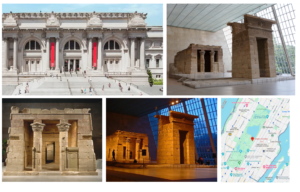“If you do not expect the unexpected you will not find it, for it is not to be reached by search or trail.”
–Heraclitus
Can you really “expect the unexpected”? I think you can be “open” to new experience. You can cultivate a flexibility toward change. But isn’t the “unexpected,” by definition, about surprise, about the unforeseen, the unanticipated? For myself, the “unexpected” always arrives without warning. Sometimes it’s welcome, sometimes it’s not, but I never see it coming.

As I’m walking through the ancient history wing the New York Metropolitan Museum of Art for the first time, I enter a room unlike all the others. Where previous galleries are mostly dark, cramped and dependent on artificial lighting, this new room is bright and airy, with a slanted wall of windows allowing natural light to flow in from the outside. Dominating the space is a small collecting pool and what appears to be an Egyptian temple, constructed from beige stone, crouching nimbly on a slight platform. What is this magnificent structure doing here, and how did this glorious room come to be established? It’s all so – well — unexpected.
As it turns out, the Temple of Dendur (as it’s called) should probably have been under submerged under a lake in Egypt. With the imminent building the Aswan Dam to control flooding of the Nile River, UNESCO thankfully went about relocating a number of the temples in the region. In 1965, the Egyptian Government gifted the temple to the US, disassembling it piece by piece and shipping it to the Met, a process which took over ten years. Visiting the Temple of Dendur is a pleasure. A careful examination of the building reveals carvings of papyrus and lotus plants, Horus the sky god, Isis, Osiris, and of course, the pharaoh. Interestingly, the pharaoh is not, in fact, an Egyptian – it’s Caesar Augustus of Rome who, as the ruler of Egypt at the time, had many temples erected in Egyptian style, honoring the local deities (and himself).
As I mentioned, what makes Dendur so cool and unexpected is its stark contrast to the other rooms in that wing of the museum. Here you feel like you can breathe, you can stretch your arms. On the one hand, you kind of feel like you’re actually in an Egyptian temple. On the other hand, you’re clearly aware that this is a modern architectural space. That juxtaposition makes you feel – I can only describe it as “happy.” Is it any surprise that I start all my NY Met treasure hunts here? Or that a key scene from the movie “When Harry Met Sally” was filmed here? (Can you say paprikash and pecan pie?) It’s a magical space that continually surprise and delights, in large part because of its unexpectedness.
(It would be very “self-help-y” for me to preach the importance of looking positively on the unexpected. But seriously folks, if you get hit by a car, or suddenly lose your job, or a loved one falls ill with cancer – are you really supposed to embrace those unexpected moments? You certainly cannot see any of that crap coming; it always arrives out of the blue. I suppose you can try adopting an attitude of “s*** happens, be ready for it,” but that seems like a cramped, over-protective way of living. Because the opposite is true as well, isn’t it – unexpected pleasures and miracles suddenly happen, too! About all you can do, I think, is be present and try to strike a balance between being ready for change but not so protective that you build fortresses around yourself to prevent yourself from being hurt. That’s the art of living.)
